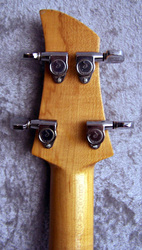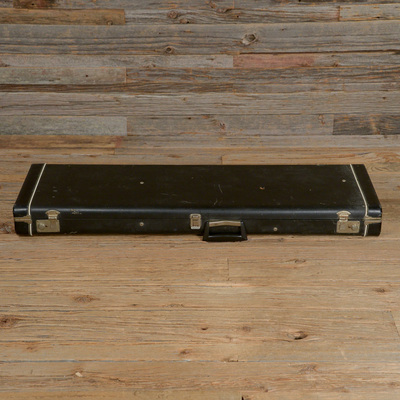D219A
This very early Dan Armstrong bass came up on the auction market in December 2011 with an initial asking price of $1,975. Comes with its original Ess & Ess case, printed 8" x 11" instruction pamphlet, and a number of extra bridges. Pickup was replaced with a newer Kent Armstrong unit as described below.
|
"Offered for sale is a very early 1969 Dan Armstrong Bass by Ampeg with original Ess & Ess hardshell case. Serial number D219A identifies it as the 119th bass of the original production run of 3,000. Besides the rare slotted-screw bridge, this bass also appears to have a unique design transition feature. The very first models had a larger pickup cavity to accommodate a chrome retainer plate screwed into the body. This bass has that larger pickup cavity, but instead of the front mounting plate, has the rear thumbscrew that became the standard method for mounting pickups. A wealth of information on the evolution of Dan Armstrong basses can be found on the authoritative www.danarmstrong.org website."
"Early Dan Armstrongs (as opposed to some reissues) featured a 30 1/2" short scale. The shorter neck makes for fast, easy fingering. You almost feel like you are playing a guitar. Yet, the powerful pickup (actually two single-coil stacked pickups) provides a rich, deep bass tone. The body is made of machined and polished clear acrylic, the same material marketed under the names Lucite and Plexiglas. Dan Armstrongs were commonly known as "see-through" guitars and basses when first introduced. The neck is quarter-sawn maple with a brazilian rosewood fingerboard. The headstock and pickguard are Formica. The earliest models, like this one, used Formica with a smooth surface. Later models had the same wood grain pattern but with a textured surface.Controls include one knob for Volume and another that blends the two single-coil stacked pickups. The blend control allows you to dial in a deep bass that moves to a clear trebly tone as you rotate the knob.The original pickup comes along with the bass, but it has been removed since only one of the coils worked. Dan Armstrong's son, Kent Armstrong, built a new replacement pickup at his shop in Vermont. It has internal components and dimensions that are identical to the original pickups. The only difference is that the original pickup is encased in a rubbery epoxy substance while the replacement is encased in hard epoxy and is a deeper brown. The bass with its new pickup is shown in the photo with the turquoise background.Save for the replacement pickup (remember, the original pickup is included) all parts are original." "The tuner knobs are originals by Schaller. Later Dan Armstrong bass models used Grover tuners.The body is in excellent condition, with only fine "micro" scratches and several microscopic chips on the front right upper bout. These can hardly be felt, do not show up in photos, and can be easily removed. Luthier Bill Richardson of Studio Guitars in Santa Fe, New Mexico, is world renowned for his restoration work on Dan Armstrong instruments. For a very affordable fee, he restores Dan Armstrong acrylic bodies to like-new condition. This kind of work performed on Dan Armstrong guitars and basses does not impact their value, according to Dan Armstrong expert Mark Schnoor, who created and maintains the Dan Armstrong website at www.danarmstrong.org. There is also a slight semi-circular scratch on the Formica headstock faceplate, caused by a rotating string tip. It also does not show up in photographs." "The bass comes with its original hardshell case, made by Ess & Ess. The case exterior is in rough condition, not unexpected for a 42-year-old instrument. Inside, some of the plush material is worn, but there are no tears. The case functions perfectly, but you probably would want to shelve it in favor of something more modern. Also included are four extra Rosewood bridges of varying heights that came with the bass, as well as the owner's manual, which was written on a typewriter and then mimeographed. Later basses came with professionally printed manuals.The bass is strung with light gauge (45-90) Rotosound flatwounds, designed for use on short-scale basses. The original Dan Armstrong basses also came with light-gauge flatwound strings. One thing about Dan Armstrong basses: despite the lighter gauge strings, you get a massive, deep bass tone. Traditional flatwounds are also kinder to frets, which on this model show very little wear." "I will do my best to answer any questions about this bass. As I noted earlier, there is a wealth of information about Dan Armstrong see-through instruments at www.danarmstrong.com. This bass is scheduled to be included on that site because of its condition and the unique pickup cavity. Because this bass is a vintage piece, I will not break it down for shipping. Some countries have size limitations on mailed packages, and if your locale in on the exclusion list, these limitations might be why." |
August 30, 2016 - D219A now comes up for sale in Chicago and is believed to have sold around the asking price of $1,495.
|
"The body on this Ampeg is in great shape, with very little wear to be found. The neck is glossy and smooth, with just a few small dings to be felt, while the headstock has a fair amount of edge wear. The strings are set up nicely with medium action, play great, and ring out clearly across the board. This Plexi bass is clearly a winner."
|






















